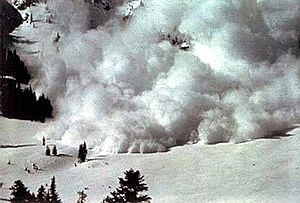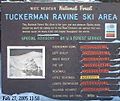Avalanche facts for kids
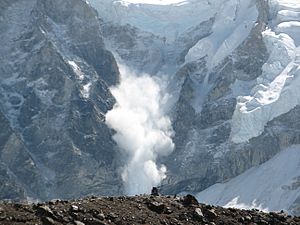
An avalanche is a phenomenon of nature. It is linked to snow. When there is too much snow on a mountain, some of the snow may fall, causing damage to things in its path. This is called an avalanche. People talk about avalanches because they may be dangerous to skiers and other people doing winter sports.
Large avalanches may carry stones, boulders and trees with them. They may bury people under them. If the people are not found rapidly enough by rescue teams they will die of suffocation (not getting enough air) or of hypothermia (freezing cold).
The chance of surviving an avalanche is as follows:
- 92% if found within 15 minutes
- 30% if found within 35 minutes (victims die of suffocation)
- nearly zero after two hours (victims die of injuries and hypothermia)
Contents
Formation
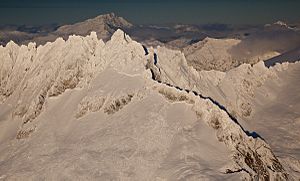
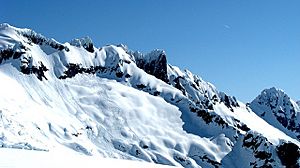
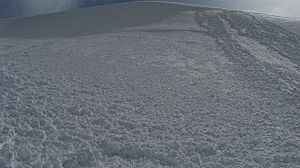
Most avalanches occur spontaneously during storms under increased load due to snowfall. The second largest cause of natural avalanches is metamorphic changes in the snowpack such as melting due to the sun. Other natural causes include rain, earthquakes, rockfall and icefall. Artificial triggers of avalanches include skiers, snowmobiles, and controlled explosive work. Contrary to popular belief, avalanches are not triggered by loud sound; the pressure from sound is orders of magnitude too small to trigger an avalanche.
Avalanche initiation can start at a point with only a small amount of snow moving initially; this is typical of wet snow avalanches or avalanches in dry unconsolidated snow. However, if the snow has sintered into a stiff slab overlying a weak layer then fractures can propagate very rapidly, so that a large volume of snow, that may be thousands of cubic meters, can start moving almost simultaneously.
A snowpack will fail when the load exceeds the strength. The load is straight forward; it is the weight of the snow. However, the strength of the snowpack is much more difficult to determine and is extremely heterogenous. It varies in detail with properties of the snow grains, size, density, morphology, temperature, water content; and the properties of the bonds between the grains. These properties may all metamorphose in time according to the local humidity, water vapour flux, temperature and heat flux. The top of the snowpack is also extensively influenced by incoming radiation and the local air flow. One of the aims of avalanche research is to develop and validate computer models that can describe the evolution of the seasonal snowpack over time. A complicating factor is the complex interaction of terrain and weather, which causes significant spatial and temporal variability of the depths, crystal forms, and layering of the seasonal snowpack.
Slab avalanches
Slab avalanches form frequently in snow that has been deposited, or redeposited by wind. They have the characteristic appearance of a block (slab) of snow cut out from its surroundings by fractures. Elements of slab avalanches include the following: a crown fracture at the top of the start zone, flank fractures on the sides of the start zones, and a fracture at the bottom called the staunchwall. The crown and flank fractures are vertical walls in the snow delineating the snow that was entrained in the avalanche from the snow that remained on the slope. Slabs can vary in thickness from a few centimetres to three metres. Slab avalanches account for around 90% of avalanche-related fatalities in backcountry users.
Powder snow avalanches
The largest avalanches form turbulent suspension currents known as powder snow avalanches or mixed avalanches. These consist of a powder cloud, which overlies a dense avalanche. They can form from any type of snow or initiation mechanism, but usually occur with fresh dry powder. They can exceed speeds of 300 kilometres per hour (190 mph), and masses of 10,000,000 tonnes (10,000,000 long tons; 10,000,000 short tons); their flows can travel long distances along flat valley bottoms and even uphill for short distances.
Wet snow avalanches
In contrast to powder snow avalanches, wet snow avalanches are a low velocity suspension of snow and water, with the flow confined to the track surface (McClung, first edition 1999, page 108). The low speed of travel is due to the friction between the sliding surface of the track and the water saturated flow. Despite the low speed of travel (~10–40 km/h), wet snow avalanches are capable of generating powerful destructive forces, due to the large mass and density. The body of the flow of a wet snow avalanche can plough through soft snow, and can scour boulders, earth, trees, and other vegetation; leaving exposed and often scored ground in the avalanche track. Wet snow avalanches can be initiated from either loose snow releases, or slab releases, and only occur in snow packs that are water saturated and isothermally equilibrated to the melting point of water. The isothermal characteristic of wet snow avalanches has led to the secondary term of isothermal slides found in the literature (for example in Daffern, 1999, page 93). At temperate latitudes wet snow avalanches are frequently associated with climatic avalanche cycles at the end of the winter season, when there is significant daytime warming.
Avalanche pathway
As an avalanche moves down a slope it follows a certain pathway that is dependent on the slope's degree of steepness and the volume of snow/ice involved in the mass movement. The origin of an avalanche is called the Starting Point and typically occurs on a 30–45 degree slope. The body of the pathway is called the Track of the avalanche and usually occurs on a 20–30 degree slope. When the avalanche loses its momentum and eventually stops it reaches the Runout Zone. This usually occurs when the slope has reached a steepness that is less than 20 degrees. These degrees are not consistently true due to the fact that each avalanche is unique depending on the stability of the snowpack that it was derived from as well as the environmental or human influences that triggered the mass movement.
Safety
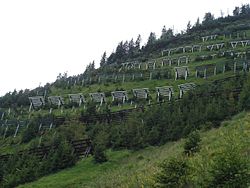
In many areas, regular avalanche tracks can be identified and precautions can be taken to minimise damage, such as the prevention of development in these areas. To mitigate the effect of avalanches the construction of artificial barriers can be very effective in reducing avalanche damage. There are several types: One kind of barrier (snow net) uses a net strung between poles that are anchored by guy wires in addition to their foundations. These barriers are similar to those used for rockslides. Another type of barrier is a rigid fence-like structure (snow fence) and may be constructed of steel, wood or pre-stressed concrete.
Early warning systems
Warning systems can detect avalanches which develop slowly, such as ice avalanches caused by icefalls from glaciers. Interferometric Radars, high-resolution Cameras, or motion sensors can monitor instable areas over a long term, lasting from days to years. Experts interpret the recorded data and are able to recognize upcoming ruptures in order to initiate appropriate measures. Such systems (e.g. the monitoring of the Weissmies glacier in Switzerland) can recognize events several days in advance.
Alarm systems
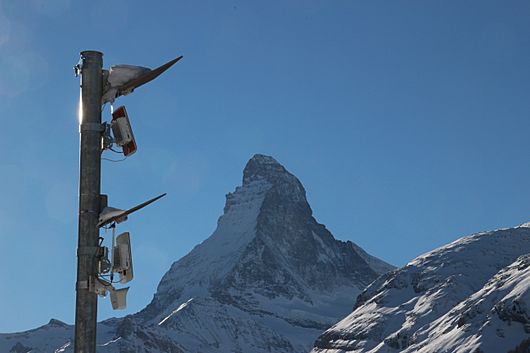
Modern radar technology enables the monitoring of large areas and the localization of avalanches at any weather condition, by day and by night. Complex alarm systems are able to detect avalanches within a short time in order to close (e.g. roads and rails) or evacuate (e.g. construction sites) endangered areas. An example of such a system is installed on the only access road of Zermatt in Switzerland. Two radars monitor the slope of a mountain above the road. The system automatically closes the road by activating several barriers and traffic lights within seconds such that no persons are harmed.
European avalanche risk table
In Europe, the avalanche risk is widely rated on the following scale, which was adopted in April 1993 to replace the earlier non-standard national schemes. Descriptions were last updated in May 2003 to enhance uniformity pdf.
| Risk Level | Snow Stability | Avalanche Risk |
|---|---|---|
| 1 - Low | Snow is generally very stable. | Avalanches are unlikely except when heavy loads [2] are applied on a very few extreme steep slopes. Any spontaneous avalanches will be minor (sluffs). In general, safe conditions. |
| 2 - Limited | On some steep slopes the snow is only moderately stable [1]. Elsewhere it is very stable. | Avalanches may be triggered when heavy [2] loads are applied, especially on a few generally identified steep slopes. Large spontaneous avalanches are not expected. |
| 3 - Medium | On many steep slopes [1] the snow is only moderately or weakly stable. | Avalanches may be triggered on many slopes even if only light loads [2] are applied. On some slopes, medium or even fairly large spontaneous avalanches may occur. |
| 4 - High | On most steep slopes [1] the snow is not very stable. | Avalanches are likely to be triggered on many slopes even if only light loads [2] are applied. In some places, many medium or sometimes large spontaneous avalanches are likely. |
| 5 - Very High | The snow is generally unstable. | Even on gentle slopes, many large spontaneous avalanches are likely to occur. |
[1] Stability:
- Generally described in more detail in the avalanche bulletin (regarding the altitude, aspect, type of terrain etc.)
[2] additional load:
- heavy: two or more skiers or boarders without spacing between them, a single hiker or climber, a grooming machine, avalanche blasting.
- light: a single skier or snowboarder smoothly linking turns and without falling, a group of skiers or snowboarders with a minimum 10 m gap between each person, a single person on snowshoes.
Gradient:
- gentle slopes: with an incline below about 30°.
- steep slopes: with an incline over 30°.
- very steep slopes: with an incline over 35°.
- extreme steep slopes: extreme in terms of the incline (over 40°), the terrain profile, proximity of the ridge, smoothness of underlying ground.
Avalanche size:
| Size | Runout | Potential Damage | Physical Size |
|---|---|---|---|
| 1 - Sluff | Small snow slide that cannot bury a person, though there is a danger of falling. | Relatively harmless to people | length <50 m volume <100 m³ |
| 2 - Small | Stops within the slope. | Could bury, injure or kill a person. | length <100 m volume <1,000 m³ |
| 3 - Medium | Runs to the bottom of the slope. | Could bury and destroy a car, damage a truck, destroy small buildings or break trees. | length <1,000 m volume <10,000 m³ |
| 4 - Large | Runs over flat areas (significantly less than 30°) of at least 50 m in length, may reach the valley bottom. | Could bury and destroy large trucks and trains, large buildings and forested areas. | length >1,000 m volume >10,000 m³ |
Notable avalanches
Two avalanches occurred in March 1910 in the Cascade and Selkirk Mountain ranges; On 1 March the Wellington avalanche killed 96 in Washington state, United States. Three days later 62 railroad workers were killed in the Rogers Pass avalanche in British Columbia, Canada.
During World War I, an estimated 40,000 to 80,000 soldiers died as a result of avalanches during the mountain campaign in the Alps at the Austrian-Italian front, many of which were caused by artillery fire. Some 10,000 men, from both sides, died in avalanches in December 1916.
In the northern hemisphere winter of 1950–1951 approximately 649 avalanches were recorded in a three-month period throughout the Alps in Austria, France, Switzerland, Italy and Germany. This series of avalanches killed around 265 people and was termed the Winter of Terror.
A mountain climbing camp on Lenin Peak, in what is now Kyrgyzstan, was wiped out in 1990 when an earthquake triggered a large avalanche that overran the camp. Forty-three climbers were killed.
In 1993, the Bayburt Üzengili avalanche killed 60 individuals in Üzengili in the province of Bayburt, Turkey.
A large avalanche in Montroc, France, in 1999, 300,000 cubic metres of snow slid on a 30° slope, achieving a speed in the region of 100 km/h (62 mph). It killed 12 people in their chalets under 100,000 tons of snow, 5 meters (16 feet) deep. The mayor of Chamonix was convicted of second-degree murder for not evacuating the area, but received a suspended sentence.
The small Austrian village of Galtür was hit by the Galtür avalanche in 1999. The village was thought to be in a safe zone but the avalanche was exceptionally large and flowed into the village. Thirty-one people died.
On 1 December 2000, the Glory Bowl Avalanche formed on Mt. Glory which is located within the Teton Mountain Range in Wyoming, United States. Joel Roof was snowboarding recreationally in this backcountry, bowl-shaped run and triggered the avalanche. He was carried nearly 2,000 feet to the base of the mountain and was not successfully rescued.
Avalanches on the planet Mars
Images for kids
-
Heavy equipment in action after an avalanche has interrupted service on the Saint-Gervais–Vallorcine railway in Haute-Savoie, France (2006).
-
In steep avalanche-prone terrain, traveling on ridges is generally safer than traversing the slopes.
-
Avalanche path with 800 metres (2,600 ft) vertical fall in the Glacier Peak Wilderness, Washington state. Avalanche paths in alpine terrain may be poorly defined because of limited vegetation. Below tree line, avalanche paths are often delineated by vegetative trim lines created by past avalanches. The start zone is visible near the top of the image, the track is in the middle of the image and clearly denoted by vegetative trimlines, and the runout zone is shown at the bottom of the image. One possible timeline is as follows: an avalanche forms in the start zone near the ridge, and then descends the track, until coming to rest in the runout zone.
-
After surface hoarfrost becomes buried by later snowfall, the buried hoar layer can be a weak layer upon which upper layers can slide.
-
United States Forest Service avalanche danger advisories.
-
Avalanche blasting in French ski resort Tignes (3,600 m)
-
Avalanche warning sign near Banff, Alberta
See also
 In Spanish: Alud para niños
In Spanish: Alud para niños


